Cheshire Diagrams: Poetics
The experiment tests the inferential practice of conduction (navigating information archive using the aesthetic relationships of dream work). Composed as images (nine diagrams consisting of twenty-two emblems), the Diagrams themselves in principle could be published in print like any other illustration, but their native existence as emblems (text/image constructions), designed using collage poetics, appropriation, visual poetics, allusion—the resources of aesthetics in short—becomes practical for general education in the digital apparatus. They were created to test the possibility of slides to stand on their own, apart from the lecture they conventionally illustrate in such software as PowerPoint or Keynote. The lectureless slide is identified as such with the name “zlide.” “The Cheshire Diagrams” demonstrate conduction testing the zlide form (sliding of the signified under the signifier).
The book, Konsult: Theopraxesis, theorized the generation of an electrate genre of education, equivalent of dialogue for digital equipment. The website, konsultexperiment.com, takes up where the book leaves off, shifting away from theory to practice (to theopraxesis). Using Plato’s Republic as template relay to generate an electrate genre, the Theory proposed the historical city of Venice, Italy, as a resource for imagining the social place in electracy that Plato outlined for literacy as an ideal Republic. Venice was selected to figure this new dimension for numerous reasons, beginning with its contemporary status as an actual place transforming into fantasy (as in Italo Calvino’s Invisible Cities). The current threat to the city posed by the overwhelming number of tourists is a symptom of what recommends it to represent the “Mecca” of electracy. This reflection on imaginal Venice is to be extended in the experiments into the more properly electrate order of theme parks, specifically in the casinos of Las Vegas, The Venetian Casino in particular.
Within the larger frame of the ideal city, Plato articulated his metaphysics in the Allegory of the Cave, perhaps the best-known fragment of philosophy in all of literacy. An ongoing experiment for konsult is to devise an equally effective allegory of electrate metaphysics. Konsult (the book) nominated the exiled Russian poet Joseph Brodsky’s Watermark, a memoir of his annual visit to Venice during the high-water month of December, as basis for an Allegory of the Wave. Venice and Watermark are transitional entries, useful for introducing the project, inviting a collaborative engagement with this challenge: imagining the place and practices of the dimension of reality under construction in electracy. Such may be an assignment organizing an entire curriculum.
“The Cheshire Diagrams” take up this challenge in a modest way, moving beyond the book and the Allegory of the Wave, performing rather than discussing electrate metaphysics. Within electracy proper the equivalent of Plato’s Republic is Walt Disney’s Disneyland (Disney World), prototype of theming. Mickey Mouse is our Socrates in this scenario. The Diagrams experiment began with the hypothesis that an allegory of electrate metaphysics (attraction/repulsion as fundamental cause) already existed in the chase genre of Cat & Mouse animation (Tom & Jerry et al). It is the reality of predation troped into a figure of insatiable desire and anxiety. This line of inquiry led to George Herriman’s Krazy Kat as most eloquent dramatization of drive energy as minimum system (Krazy, Officer Pupp, Ignatz, Brick), and finally to the Cheshire Cat in Lewis Carroll’s Alice in Wonderland. The series of emblems uses the inferential process of conduction (dada bachelor machine logic) to explore a cat-mouse joke in Alice (the gag is to konsult what dialectic is to dialogue). The joke is based on a macaronic pun: la souris in French means “smile,” “mouse,” and “girl” (in slang). The discovery of the experiment is that the Cheshire Cat’s grin functions as an equivalent in theopraxesis for category in literate reasoning: the syntagm of a grin without a cat separates from its context to circulate through information as a support for inference by means of aesthetics (Kant’s reflective judgment). A first response to this discovery (conduction as a mode of inference navigates information passing from the known into the unknown) is that there are other such primary image/texts already extant, modeling a poetics for creative metaphysics. “The Cheshire Diagrams” models an operation for itself but also as an invitation and call for collaboration.


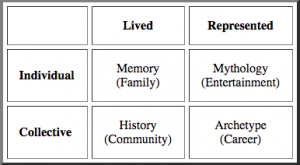 Structuralism: Claude Lévi-Strauss. Following the rule of heuretics curriculum, to treat one’s own materials as belonging to the disciplinary tradition, I applied Lévi-Strauss’s insights into the formal design of mythologies to my wide image. The wide mage in fact is a personal mythology, not only metaphorically but formally. Lévi-Strauss showed that individual instances of a myth manifest a system of relationships, covering all possible variations on the aporia (disaster in our terms) addressed by the myth. The system of relationships is that of proportional analogy (A is to B as C is to D), the figure of hypotyposis encountered throughout the tradition. The practice of myth-work applied to a mystory set (including the Career register documented, along with Family, Entertainment, Community) is to determine which stories/scenes are related in this proportional ratio, along what axes? In my case I found Family and Career related on an axis of space (The Sand and Gravel Plant scene, materializing the Choral metaphor of Plato and Derrida); Entertainment and History related on an axis of time. High Noon plays out almost in real time, intercutting between the clock in the sheriff’s office and the gunmen waiting for their boss to arrive on the noon train, while the sheriff tries to form a posse to fight them. Custer took his Seventh Cavalry far ahead of the rest of the advancing army, hoping to strike a quick blow against the Indians, to get the glory for himself, to propel him into candidacy for President of the United States in the 1876 election.. The symmetries formed in the crossings of this four-fold are provocative, suggestive of a diagram capable of translation into an original hypothesis for konsult.
Structuralism: Claude Lévi-Strauss. Following the rule of heuretics curriculum, to treat one’s own materials as belonging to the disciplinary tradition, I applied Lévi-Strauss’s insights into the formal design of mythologies to my wide image. The wide mage in fact is a personal mythology, not only metaphorically but formally. Lévi-Strauss showed that individual instances of a myth manifest a system of relationships, covering all possible variations on the aporia (disaster in our terms) addressed by the myth. The system of relationships is that of proportional analogy (A is to B as C is to D), the figure of hypotyposis encountered throughout the tradition. The practice of myth-work applied to a mystory set (including the Career register documented, along with Family, Entertainment, Community) is to determine which stories/scenes are related in this proportional ratio, along what axes? In my case I found Family and Career related on an axis of space (The Sand and Gravel Plant scene, materializing the Choral metaphor of Plato and Derrida); Entertainment and History related on an axis of time. High Noon plays out almost in real time, intercutting between the clock in the sheriff’s office and the gunmen waiting for their boss to arrive on the noon train, while the sheriff tries to form a posse to fight them. Custer took his Seventh Cavalry far ahead of the rest of the advancing army, hoping to strike a quick blow against the Indians, to get the glory for himself, to propel him into candidacy for President of the United States in the 1876 election.. The symmetries formed in the crossings of this four-fold are provocative, suggestive of a diagram capable of translation into an original hypothesis for konsult.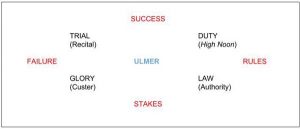
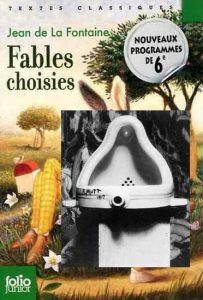 –Fable: What resources are available for inquiry and expression in the conditions after Nietzsche, the history of an error, after the simultaneous withdrawal of the true world and the apparent world along with it? The time is noon (the shortest shadow). What remains is fable, Nietzsche said. What are the possibilities of fable as genre? Duchamp improvised one approach, perhaps not even yet fully appreciated. His Readymades are fables, albeit weak (faible) fables, in that they provide the illustrations only (the emblems, impresas). He intimated his variation on the mode with his most notorious instance, whose title “Fountain” translates “La Fontaine,” antonomasia between common and proper noun, evoking the name of the author of many fables in the common “fountain,” itself a euphemistic title for a urinal. Ulmer’s collage of the urinal with a cover of La Fontaine’s book make the joke explicit. Duchamp’s commitment to the punning bachelor machine logic central to modernism is well known. He acknowledged his attendance at a performance of a stage adaptation of Raymond Roussel’s 1910 novel Impressions of Africa as a turning point in his career (Roussel’s method of composition used generative puns). It has been suggested that some of the Readymades at least are comments on dreams described in Freud’s Interpretation of Dreams, hence that they use rebus methods (visualizations evoking words). Freud noted, for example, that many dreams are triggered when sleepers experience the need to urinate (the dream allows sleep to continue briefly). The text of the fabled fountain is provided by its history, being as it is the most influential (if not the “best”) art work of the twentieth century, including its status as a prank, and all the manipulations Duchamp performed to put the image of La Fontaine into circulation, recorded in Thierry De Duve’s Kant After Duchamp. What is the moral of the readymade fable?
–Fable: What resources are available for inquiry and expression in the conditions after Nietzsche, the history of an error, after the simultaneous withdrawal of the true world and the apparent world along with it? The time is noon (the shortest shadow). What remains is fable, Nietzsche said. What are the possibilities of fable as genre? Duchamp improvised one approach, perhaps not even yet fully appreciated. His Readymades are fables, albeit weak (faible) fables, in that they provide the illustrations only (the emblems, impresas). He intimated his variation on the mode with his most notorious instance, whose title “Fountain” translates “La Fontaine,” antonomasia between common and proper noun, evoking the name of the author of many fables in the common “fountain,” itself a euphemistic title for a urinal. Ulmer’s collage of the urinal with a cover of La Fontaine’s book make the joke explicit. Duchamp’s commitment to the punning bachelor machine logic central to modernism is well known. He acknowledged his attendance at a performance of a stage adaptation of Raymond Roussel’s 1910 novel Impressions of Africa as a turning point in his career (Roussel’s method of composition used generative puns). It has been suggested that some of the Readymades at least are comments on dreams described in Freud’s Interpretation of Dreams, hence that they use rebus methods (visualizations evoking words). Freud noted, for example, that many dreams are triggered when sleepers experience the need to urinate (the dream allows sleep to continue briefly). The text of the fabled fountain is provided by its history, being as it is the most influential (if not the “best”) art work of the twentieth century, including its status as a prank, and all the manipulations Duchamp performed to put the image of La Fontaine into circulation, recorded in Thierry De Duve’s Kant After Duchamp. What is the moral of the readymade fable?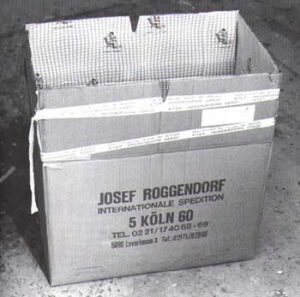 –Martin Kippenberger, “Rameau’s Nephew,” 1988
–Martin Kippenberger, “Rameau’s Nephew,” 1988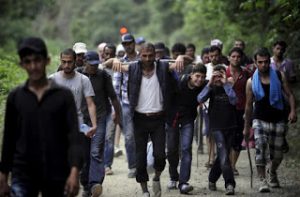 Conduction (the fourth inference) is visceral. The image logic (reasoneon) we are developing as Gest suffers fallacies just as does the reasoning of abduction, deduction, and induction. Physiognomic inference operates in the type-casting of cinema, exploiting the same emblematics as racism, as in Nazi propaganda. This danger is a reminder that electrate rhetoric articulates the visceral dimension of intelligence (racists are physically repulsed by miscegenation, for example). This effect of concrete logic should not be denied or euphemized, but addressed as a resource in understanding the thymotic force operating in personal and public discourse.
Conduction (the fourth inference) is visceral. The image logic (reasoneon) we are developing as Gest suffers fallacies just as does the reasoning of abduction, deduction, and induction. Physiognomic inference operates in the type-casting of cinema, exploiting the same emblematics as racism, as in Nazi propaganda. This danger is a reminder that electrate rhetoric articulates the visceral dimension of intelligence (racists are physically repulsed by miscegenation, for example). This effect of concrete logic should not be denied or euphemized, but addressed as a resource in understanding the thymotic force operating in personal and public discourse.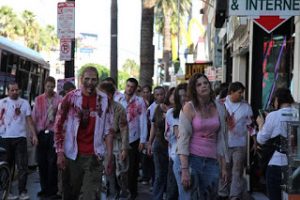 The existence of polysemous meaning has been noted throughout history–the repetition of patterns, the isotopies relating the different registers of the semiosphere (Lotman). Learning how to read these patterns is part of theopraxesis, since in the condition of the General Accident (that happens everywhere simultaneously [Virillio]) judgment and decision must be capable of registering macrocosm from details. That recognition of patterns does not dictate interpretation directly, to which may be added the Casandra effect. One of the better known examples of anticipation of disaster is the novel Futility, or The Wreck of the Titan, the 1898 novel by Morgan Robertson that foretold (in retrospect) the sinking of the Titanic (1912).
The existence of polysemous meaning has been noted throughout history–the repetition of patterns, the isotopies relating the different registers of the semiosphere (Lotman). Learning how to read these patterns is part of theopraxesis, since in the condition of the General Accident (that happens everywhere simultaneously [Virillio]) judgment and decision must be capable of registering macrocosm from details. That recognition of patterns does not dictate interpretation directly, to which may be added the Casandra effect. One of the better known examples of anticipation of disaster is the novel Futility, or The Wreck of the Titan, the 1898 novel by Morgan Robertson that foretold (in retrospect) the sinking of the Titanic (1912).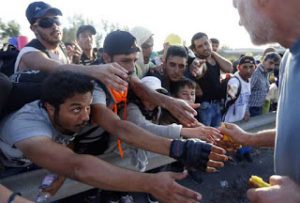
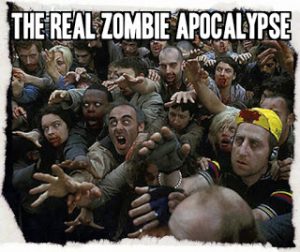 Many reports indicate that many millions of people will be displaced by these conditions globally. The present crisis is advanced warning of what is to come on a much larger scale. What policy response is in keeping with the imperative of well-being against disaster? The Zombie scenario warns of total war. Philosophers such as Jacques Derrida urge the self-described impossibility of Hospitality. It is important to note that left theory long ago identified our horror motifs as icons and emblems of life under Capitalism. Politics in any case concerns the just allocation of finite resources. The General Accident of climate change demands a holistic response.
Many reports indicate that many millions of people will be displaced by these conditions globally. The present crisis is advanced warning of what is to come on a much larger scale. What policy response is in keeping with the imperative of well-being against disaster? The Zombie scenario warns of total war. Philosophers such as Jacques Derrida urge the self-described impossibility of Hospitality. It is important to note that left theory long ago identified our horror motifs as icons and emblems of life under Capitalism. Politics in any case concerns the just allocation of finite resources. The General Accident of climate change demands a holistic response.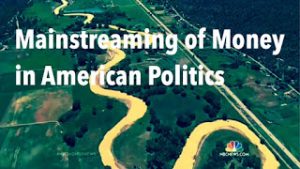 Event Gest.
Event Gest. 
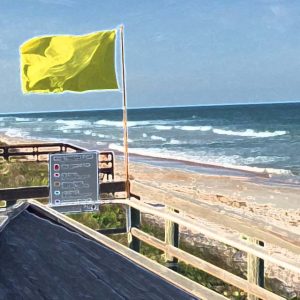 Everyday life is a dimension of the lifeworld addressed in the tradition of Arts & Letters disciplines dating back to Marx’s commentaries on the revolutions in France (Paris) beginning in the middle of the nineteenth century. The issue is central to electracy, in that the digital apparatus is associated with the rise of the industrial city. The primary institutional condition to be remedied through a new (image) metaphysics is the impoverishment of everyday life codified in the concepts of alienation, reification, objectification. Marx diagnosed the problem as due to the division of labor, and the new cultural and social environment created by the commodity form in market capitalism under bourgeois hegemony. Life in the industrial city became “uncanny,” due to a discontinuity, disjunction, between individual agency and collective events. An equivalent of the Unconscious opened within culture, a return of the repressed in which citizens suffered the consequences of their collective actions as if visited upon them by divine powers (commodity fetishism). “Routine” in this context is the habituation of daily ritual that must be dispersed by means of shock arts devices of estrangement (defamiliarization).
Everyday life is a dimension of the lifeworld addressed in the tradition of Arts & Letters disciplines dating back to Marx’s commentaries on the revolutions in France (Paris) beginning in the middle of the nineteenth century. The issue is central to electracy, in that the digital apparatus is associated with the rise of the industrial city. The primary institutional condition to be remedied through a new (image) metaphysics is the impoverishment of everyday life codified in the concepts of alienation, reification, objectification. Marx diagnosed the problem as due to the division of labor, and the new cultural and social environment created by the commodity form in market capitalism under bourgeois hegemony. Life in the industrial city became “uncanny,” due to a discontinuity, disjunction, between individual agency and collective events. An equivalent of the Unconscious opened within culture, a return of the repressed in which citizens suffered the consequences of their collective actions as if visited upon them by divine powers (commodity fetishism). “Routine” in this context is the habituation of daily ritual that must be dispersed by means of shock arts devices of estrangement (defamiliarization).
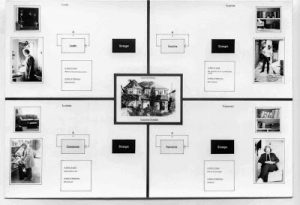 When it comes to the image of wide scope (four or five fundamental images structuring imagination, and central to the history of invention), the prototype is Einstein’s compass (received from his father as a gift at age four or five): the wide image is a compass for the existential positioning system of learning, to orient egents tracking the vector of invention.
When it comes to the image of wide scope (four or five fundamental images structuring imagination, and central to the history of invention), the prototype is Einstein’s compass (received from his father as a gift at age four or five): the wide image is a compass for the existential positioning system of learning, to orient egents tracking the vector of invention.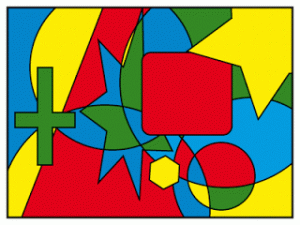 Popcycle. Learning is a complex adaptive system, and an aspect of what we are exploring is a certain isomorphism transversing all such systems. Heuretic pedagogy is describable within a systems perspective, beginning with the
Popcycle. Learning is a complex adaptive system, and an aspect of what we are exploring is a certain isomorphism transversing all such systems. Heuretic pedagogy is describable within a systems perspective, beginning with the 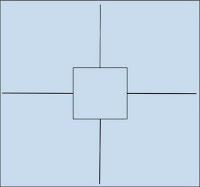 –Mandala. A basic diagram (popcycle mandala) is used consistently throughout KE to map and correlate correspondences across the layers and levels of the popcycle-mystory-wide image as Interface for the Stack of digital civilization. The diagram is not original, but is appropriated from various fourfold system templates. The diagram below registers the CATTt of a seminar documented in Ulmer’s blog,
–Mandala. A basic diagram (popcycle mandala) is used consistently throughout KE to map and correlate correspondences across the layers and levels of the popcycle-mystory-wide image as Interface for the Stack of digital civilization. The diagram is not original, but is appropriated from various fourfold system templates. The diagram below registers the CATTt of a seminar documented in Ulmer’s blog, 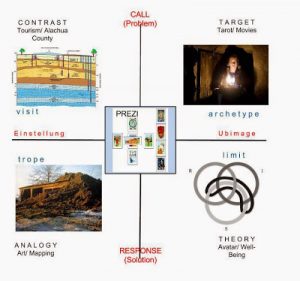
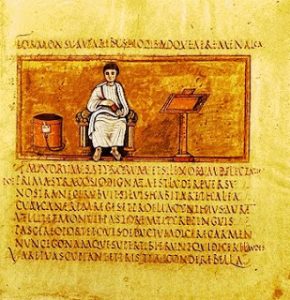 From Agent to Egent. These posts undertake a meandering trace of inquiry. KE reviews Ulmer’s work of the past four+ decades in order to understand it again, whole, as if given all at once, in a flash of insight. Egents undertaking konsult are interlocutors, collaborators, tutors. The purpose is to compose and design a discourse on method, in the tradition running from Plato’s Phaedrus to contemporary French philosophy, describing and testing a mode of learning native to electracy (the digital apparatus). The outline necessarily begins in literacy and school. The coming pedagogy is also explored elsewhere, in the context of EmerAgency (conceptual konsulting, without portfolio), addressing the curriculum reform in progress at MIT as well as Digital Humanities institutionalization. The discussion across disciplines concerns TPE (Theopraxesis)–a shared interest in learning how to learn in digital civilization, using heuretics, the logic of invention.
From Agent to Egent. These posts undertake a meandering trace of inquiry. KE reviews Ulmer’s work of the past four+ decades in order to understand it again, whole, as if given all at once, in a flash of insight. Egents undertaking konsult are interlocutors, collaborators, tutors. The purpose is to compose and design a discourse on method, in the tradition running from Plato’s Phaedrus to contemporary French philosophy, describing and testing a mode of learning native to electracy (the digital apparatus). The outline necessarily begins in literacy and school. The coming pedagogy is also explored elsewhere, in the context of EmerAgency (conceptual konsulting, without portfolio), addressing the curriculum reform in progress at MIT as well as Digital Humanities institutionalization. The discussion across disciplines concerns TPE (Theopraxesis)–a shared interest in learning how to learn in digital civilization, using heuretics, the logic of invention.